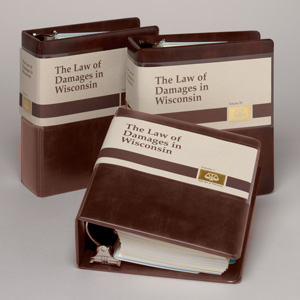
April 5, 2023 – When “Making a Murderer” was released on Netflix in December 2015, it became an instant runaway hit. Widely viewed in its two seasons, the documentary series won several awards and generated interest and controversy surrounding the conviction of Steven Avery and his nephew, Brendan Dassey, in the death of Teresa Halbach in 2005.
The series, which followed the case for several years, included many law enforcement officials in the Manitowoc Sheriff’s Office, including then-sergeant Andrew Colborn, now retired.
Colborn in December 2018 filed a federal defamation suit against Netflix and its producers, outlining the backlash he said he suffered as a result of the series.1
Colborn’s claims were dismissed in March 2023 on the defendants' summary judgment motion, but the case brings to public view the difficulty of handling a defamation suit.
Defining Defamation and Damages
Wisconsin criminal law, Wis. Stat. section
942.01(2), defines defamatory matter as “anything which exposes the other to hatred, contempt, ridicule, degradation or disgrace in society or injury in the other’s business or occupation.”
Defamation is concerned with the invasion of a person’s interest in that person’s reputation and good name, explains Atty. Melita Mullen in chapter 11, “Defamation,” of volume 1 of
The Law of Damages in Wisconsin from State Bar of Wisconsin PINNACLE®.2
Yet the law of defamation is at times confusing, and is “an area of law renowned for its complexity,” Mullen writes.
She continues with this insight: The first question a court asks when evaluating a defamation claim is whether the communication is capable of a defamatory meaning, that is, whether the words complained of are “reasonably capable of conveying a defamatory meaning to the ordinary mind and whether the meaning ascribed by [the] plaintiff[] is a natural and proper one.”3
Defamatory communications usually consist of a statement of fact; expressions of opinion are not actionable unless they are couched as “mixed opinions” that contain implied statements of fact.4
Had the case continued, there might have been a consideration of damages. The term “damages” is used in two senses in defamation cases, Mullen writes, sometimes to describe the harm inflicted and, at other times, to describe the amount awarded to compensate for such harm.
For example, the term “general damages” has most often been used to describe harm of a type not easily estimable in monetary terms, such as injury to feelings or reputation, and anguish or humiliation.5
The term has also been used to describe the amount to be awarded to a plaintiff for such harm.6 Although the term “special damages” has been used most often to describe harm of a material, economic, or pecuniary nature,7 it has also been used to describe the amounts to be recovered by a plaintiff for such harm.8
Mullen offers this comment: “Although confusion would be avoided if the terms ‘general harm’ and ‘special harm’ were used to describe the types of injuries inflicted and the terms ‘general damages’ and ‘special damages’ to describe amounts awarded as compensation for injuries, the cases make no such clear distinction.”9
More About The Law of Damages in Wisconsin

The Law of Damages in Wisconsin from State Bar of Wisconsin PINNACLE is a comprehensive statement of Wisconsin law governing the recovery of damages that provides guidance on the types of damages available in Wisconsin and the special rules governing them. It is available
in print, or through
Books Unbound.
Written in the “black letter” style, virtually every statement in The Law of Damages in Wisconsin about the past or present state of Wisconsin law is followed by a citation to the case law. The 41 chapters in this three-volume set cover all of the following and more:
The types of damages available in Wisconsin
Practical information on practice and procedure
Detailed information about damages in specific types of cases
Explanations of special rules governing damages, such as mitigation of damages, contributory negligence, subrogation, and interest
The Law of Damages in Wisconsin is an essential part of a litigator’s library in helping you research, analyze, and evaluate your cases.
What is Books Unbound?
Books UnBound® is the exclusive online digital resource from State Bar of Wisconsin PINNACLE® Books. Since 2010, many of the “brown binders” and other treatises that lawyers have relied on for decades have been available in a digital format, which was recently upgraded through a partnership with Lexum, a legal software company.
“It’s faster with a more modern look and feel, includes a more robust search function with Boolean and natural search options, and gives users one-click access to case law through Fastcase and primary law on official websites,” said Carol Chapman, publications manager for the State Bar of Wisconsin.
“It also provides an expanded ability to create and search your notes, including the ability to embed URL links, images, and other helpful information directly in the notes and to print your notes with both the highlighted book text and your user-added comments.
Endnotes
1Colborn v. Netflix Inc., No. 19-CV-0484-BHL, 2023 WL 2482620 (E.D. Wis. Mar. 10, 2023).
2The Law of Damages in Wisconsin (Russell M. Ware ed., 9th ed. 2023).
3Bauer v. Murphy, 191 Wis. 2d 517, 523, 530 N.W.2d 1 (Ct. App. 1995) (quoted sources omitted; brackets in original).
4Laughland, 2015 WI App 70, ¶ 27,
365 Wis. 2d 148;
see alsoKopp v. School Dist. of Crivitz, No. 2016AP945, 2017 WL 4413020, ¶ 39 (Wis. Ct. App. Oct. 3, 2017) (unpublished opinion not citable per
Wis. Stat. § 809.23(3)).
5Lawrence v.
Jewell Cos., 53 Wis. 2d 656, 660,
193 N.W.2d 695 (1972);
see also 50 Am. Jur. 2d
Libel and Slander § 353; 53 C.J.S.
Libel and Slander; Injurious Falsehood §§ 284, 287, 288 (2017); Restatement (Second) of Torts § 621 cmt. A (1977) (discussing meaning of term “general damages”).
6 50 Am. Jur. 2d
Libel and Slander § 360;
see alsoMartin, 15 Wis. 2d at 459 (calling amounts recoverable for injury to reputation, good name, and feelings “general compensatory damages”); Restatement (Second) of Torts § 621 cmt. a (1977) (describing general damages as those imposed to compensate plaintiff for injury to plaintiff’s reputation).
7Lawrence, 53 Wis. 2d at 660;
Starobin, 94 Wis. 2d at 13.
8 50 Am. Jur. 2d
Libel and Slander § 360.
9 Melita M. Mullen, Chapter 11: “Defamation,”
The Law of Damages in Wisconsin (Russell M. Ware ed., 9th ed. 2023).
